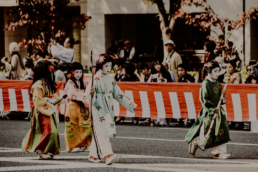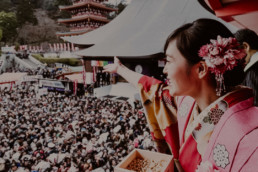Jidai Matsuri
Lo Jidai Matsuri ( 時代祭り, letteralmente “Il Festival delle epoche storiche”), celebrato a Kyoto il 22 Ottobre di ogni anno. Questo festival rappresenta una magnifica opportunità per vivere come diretti spettatori oltre mille anni di storia feudale giapponese in un unico giorno.
Jidai Matsuri, il Festival delle epoche storiche
Guest Author: Myriam

photo credits: travel-on.planet-muh.de
Le origini
Questa festività affonda infatti le proprie radici nella storia più antica del Giappone e rievoca, attraverso un’imponente parata storica in costume, gli eventi ed i personaggi che hanno segnato la vita della città dalla sua fondazione. Si tiene dal 794 ad opera dell’Imperatore Kanmu (桓武天皇, Kanmu Tennō), fino al trasferimento della capitale ad Edo nel 1868 per decisione dell’Imperatore Mitsuhito.
Dalla sua creazione con il nome di Heian Kyo (平安京, "capitale di tranquillità e pace"), Kyoto è rimasta capitale del Giappone quasi ininterrottamente per oltre mille anni. Con la fine dello shogunato Tokugawa e l’inizio dell’Era Meiji, l’intera corte imperiale fu trasferita ad Edo, che divenne così Tokyo (東京, letteralmente “capitale orientale”).
Nel 1895 in occasione del 1100° anniversario della fondazione, i governi della città e della prefettura di Kyoto istituirono lo Jidai Matsuri con l’intento di ridare lustro all’antica capitale. Insieme a questo, lo scopo era onorare la memoria degli imperatori Kanmu e Komei attraverso la costruzione del maestoso santuario Heian.
Mille anni di storia in cammino
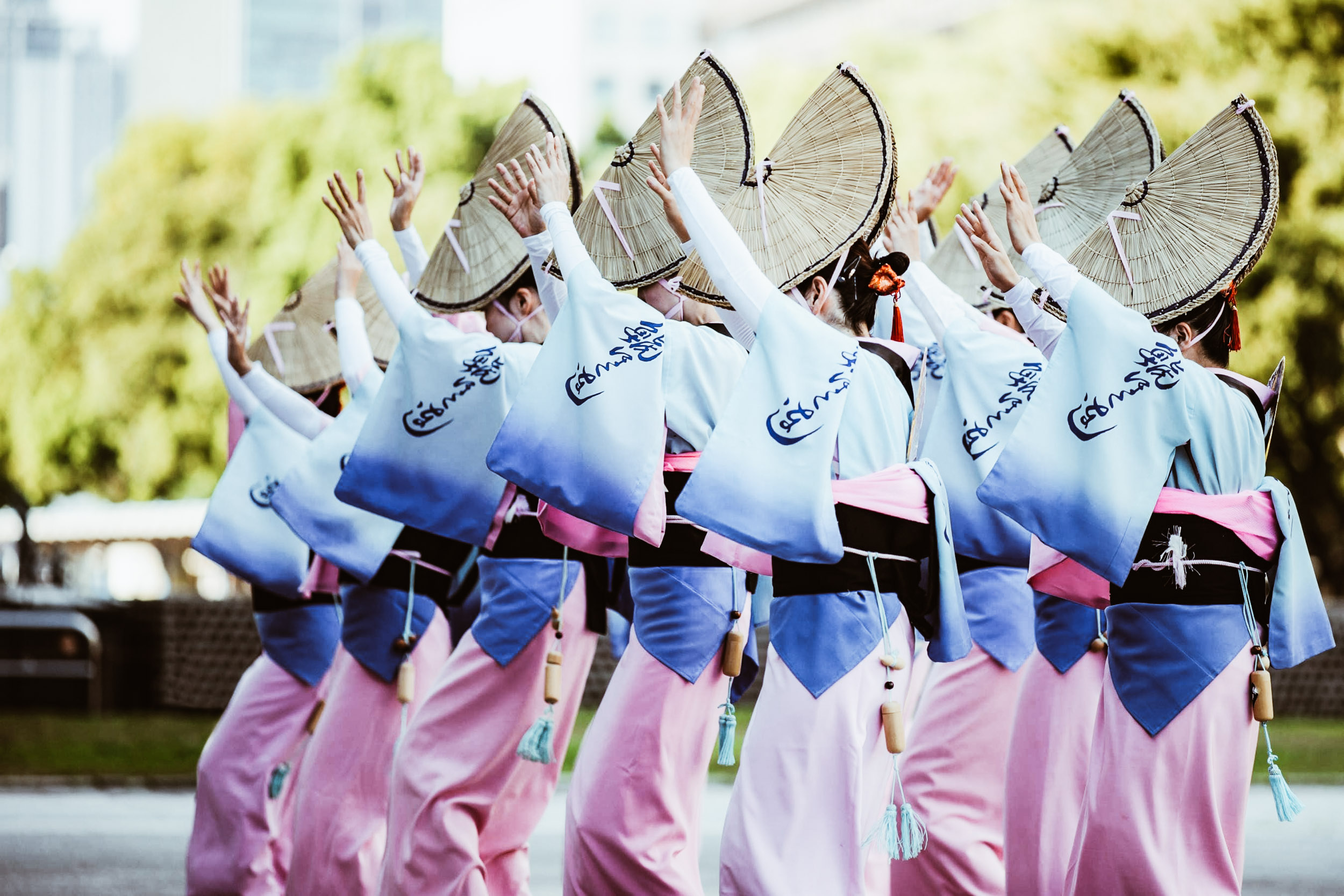
photo credits: fodors.com
Da allora il 22 Ottobre di ogni anno lo Jidai Matsuri riporta in vita lo splendore del Giappone feudale. Questo consente a residenti e turisti di rivivere per alcune ore la vita dell’antica capitale. Ai giorni nostri, infatti, l’attrazione principale del festival è rappresentata dal Jidai Gyoretsu. Si tratta di una parata storica alla quale prendono parte oltre duemila figuranti, vesti con abiti d’epoca o con costumi minuziosamente riprodotti dagli artigiani di Kyoto.
Alla testa della parata si trovano i mikoshi (santuari portatili) dedicati agli imperatori Kanmu e Komei ed i commissari onorari del festival, su carrozze trainate da cavalli nello stile di metà ‘800 e di lì il corteo si dipana in ordine cronologico inverso, dall’Era Meiji fino al periodo Heian, attraverso circa venti gruppi tematici, che permettono di riscoprire, era dopo era, i personaggi che hanno contribuito alla storia della città, dai semplici contadini e soldati, fino a figure storiche prestigiose, come gli unificatori del Paese Oda Nobunaga, Toyotomi Hideyoshi e Tokugawa Ieyasu, oppure figure di rilievo religioso o culturale, come Murasaki Shikibu, autrice del celebre “Genji monogatari”. I figuranti sono accompagnati dalla musica di tamburi e flauti, che insieme agli oltre 12.000 reperti storici utilizzati, consentono agli spettatori di immergersi completamente nell’atmosfera delle epoche passate.
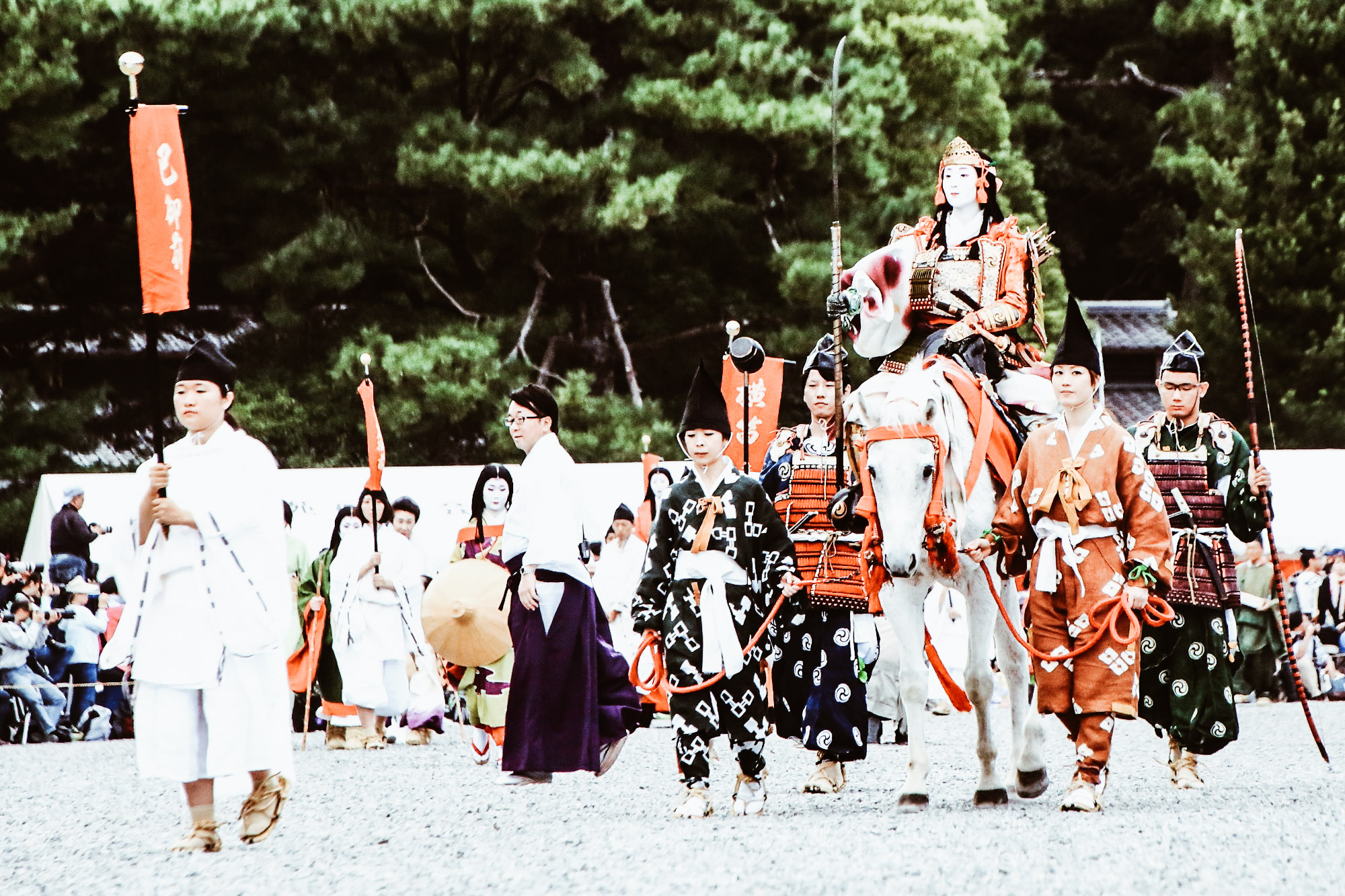
photo credits: blog.halal-navi.com
Il lungo corteo parte alle ore 12.00 dal Kyoto Gosho, il palazzo imperiale. Si snoda poi per ore nelle vie del centro della città, toccando i luoghi più suggestivi e significativi. Lo vediamo infatti passare da Oike e il quartiere Okazaki, per giungere infine al Santuario Heian. Qui il Festival si conclude con le cerimonie previste dal rito shintoista.
Yuki-Onna: la misteriosa incarnazione dell’inverno giapponese
Nello sterminato mondo degli yokai (creature soprannaturali della tradizione giapponese), spicca la figura della Yuki-Onna (雪女). Leggendaria donna delle nevi, col suo fascino algido e letale incarna la terribile bellezza dell’inverno nelle montagne del Giappone.
Pur essendo conosciuta con nomi e storie differenti nelle diverse prefetture, questo personaggio è rinomato soprattutto delle zone più fredde ed impervie dell’arcipelago.
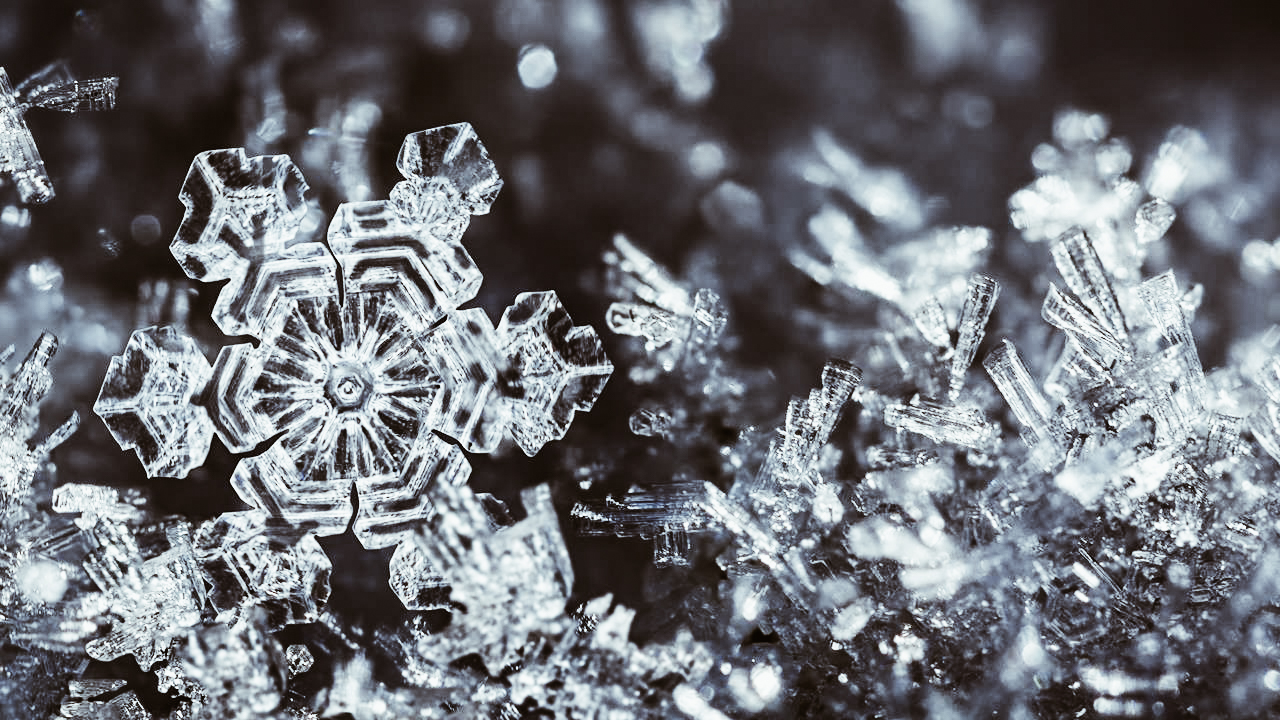
La Yuki-onna viene descritta come una donna bellissima dalla pelle candida, che appare sui sentieri di montagna e nelle tempeste di neve. La raffigurano vestita di un leggero kimono bianco o nuda e coperta solo dai lunghissimi capelli, neri o candidi a seconda delle leggende. Apparizione eterea e fluttuante nel paesaggio innevato sul quale non lascia impronte, può improvvisamente scomparire trasformandosi in una nube di nebbia o di neve finissima.
Yuki-Onna: le Origini
L’origine di questa figura, come di altri yokai, si perde nei tempi più antichi. La prima traccia scritta della sua storia si ritrova nel Sōgi Shokoku Monogatari, risalente al periodo Muromachi (1333-1573). Qui il monaco Sogi descrive l’incontro con una donna di straordinaria bellezza durante la sua permanenza nella provincia di Echigo (attuale prefettura di Niigata). Questa donna misteriosa era vestita di bianco, alta e dalla carnagione pallidissima e con lunghi capelli candidi. Dall’aspetto di giovane età, ella apparve misteriosamente un mattino nel giardino ghiacciato del monaco. Tuttavia, scomparve altrettanto misteriosamente sotto lo sguardo incredulo dell’uomo.
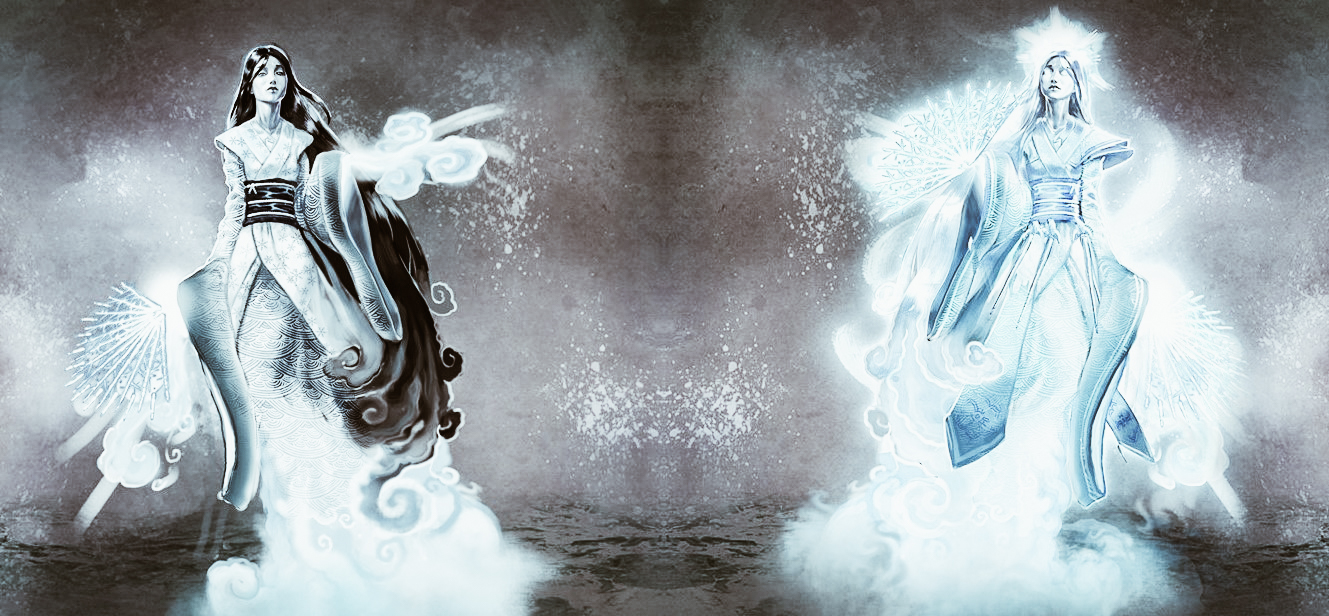
photo credits: smitefire.com
I due volti dell’inverno
Come l’inverno che può manifestarsi con un abbagliante e sereno splendore oppure con una forza crudele e letale, così è la Yuki-onna. A volte essa appare come una spietata predatrice che attrae i viandanti smarriti nella tormenta per nutrirsi vampirescamente della loro energia vitale. Altre volte appare come una presenza benevola o addirittura a sua volta sedotta dal fascino umano.
Nelle storie più antiche prevale l’aspetto mostruoso e distruttore. Infatti in questi racconti, i genitori che hanno smarrito i propri figli in montagna vengono avvicinati da una donna. Essa chiede loro di prendere in braccio un bambino che lei stessa non riesce a portare. Gli incauti che accettano tale invito sono destinati a morire assiderati, sopraffatti dalla stanchezza di portare un fardello più pesante ad ogni passo.
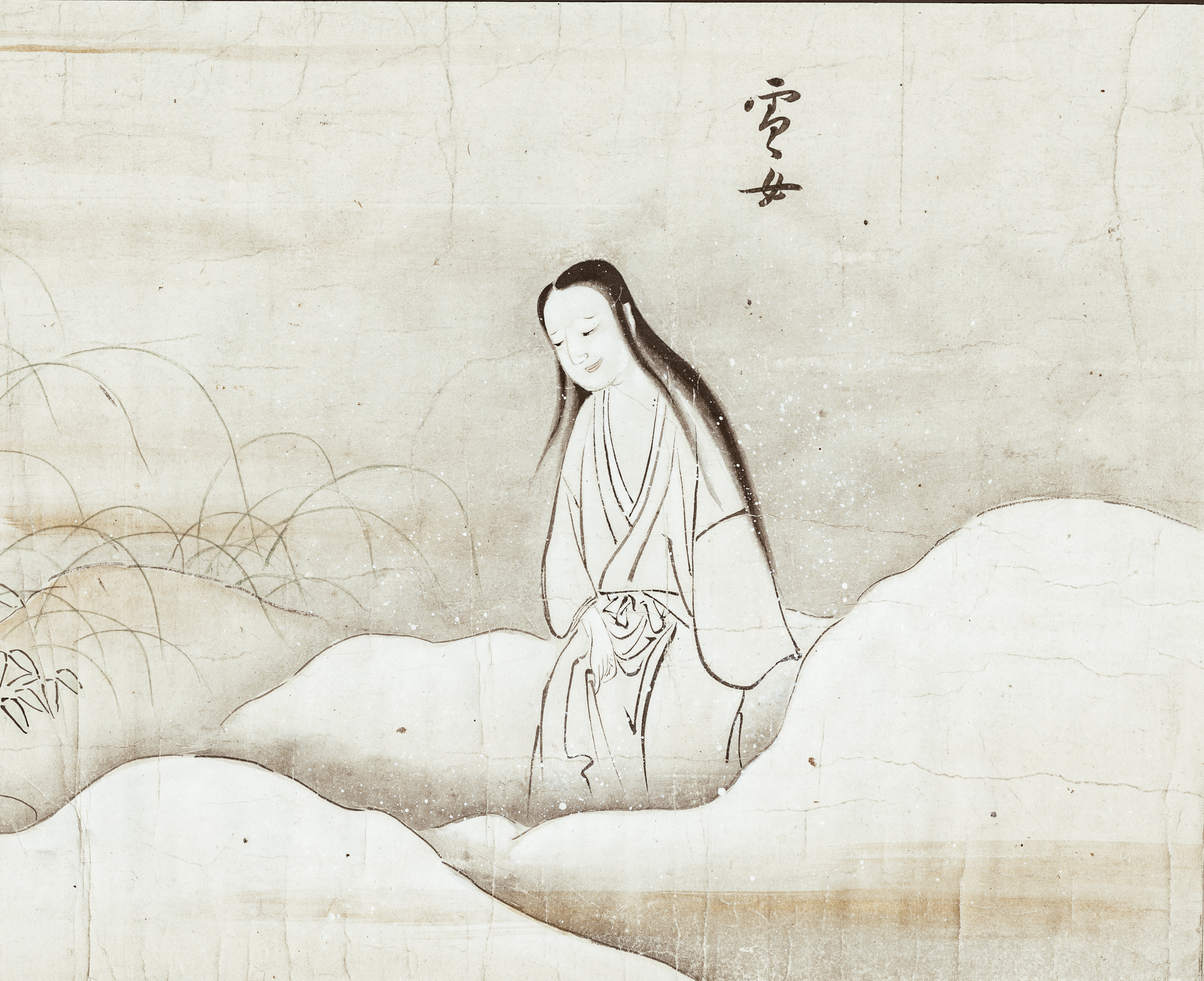
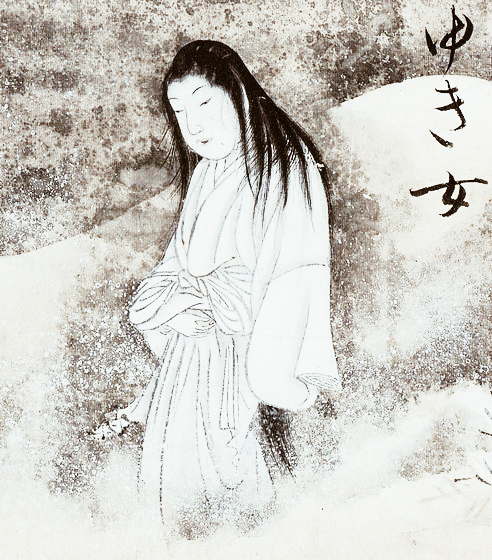
photo credits: wikipedia.org
Oppure in altre storie, la Yuki-Onna seduce uomini soggiogati dal suo fascino ultraterreno. Questi finiscono per soccombere al suo bacio mortale, capace di prosciugare la loro forza vitale e congelare i loro cuori. O ancora in racconti drammatici, in cui la Yuki-Onna non si limita ad attendere il passaggio di viandanti disorientati. Qui infatti, essa entra prepotentemente nelle case, spalancando porte e finestre sotto forma di violente tormente di neve uccidendo i malcapitati abitanti.
In Occidente conosciamo un aspetto più romantico di queste leggente. Questo avviene soprattutto grazie all’opera di Patrick Lafcadio Hearn, giornalista e scrittore irlandese naturalizzato giapponese, conosciuto anche come Koizumi Yakumo (小泉八雲).
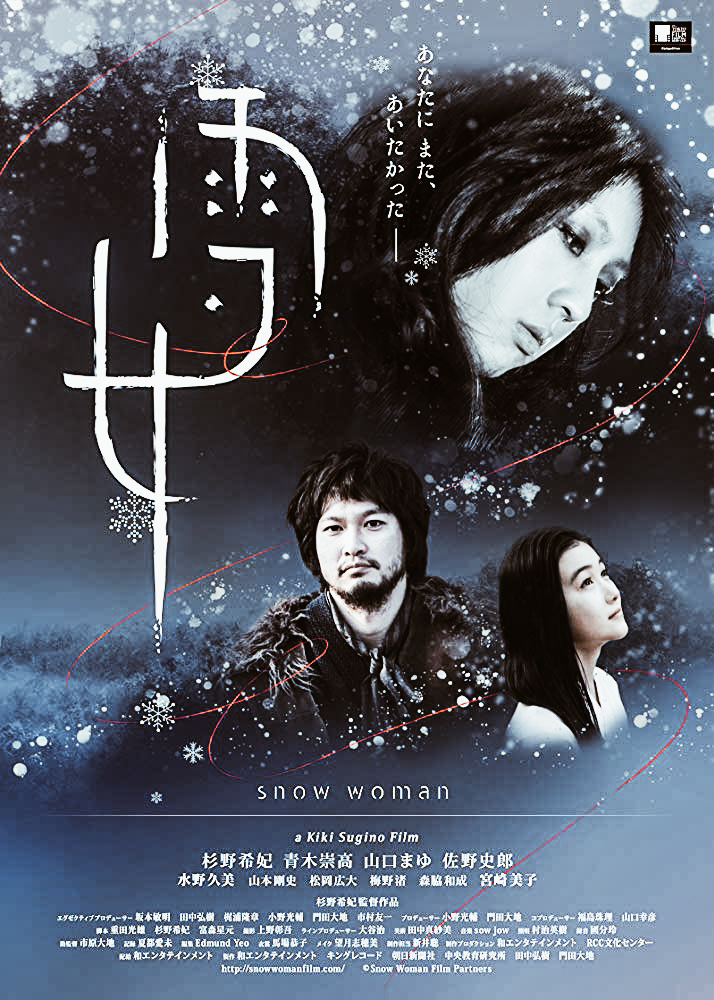
photo credits: letterboxd.com
La versione di Lafcadio
“Kwaidan: Stories and Studies of Strange Things” è opera del 1904 contenente una raccolta di credenze popolari e anche un'interpretazione della cultura e dei costumi del Giappone. Qui la leggenda narrata da Hearn parla di due boscaioli, l’anziano Mosaku ed il suo giovane apprendista Minokichi, che tornano a casa dopo una giornata di lavoro in una fredda sera. I due personaggi sorpresi da una violenta tempesta di neve, trovano riparo in una capanna vicino ad un fiume. A seguire, i due uomini si adagiano sul pavimento della capanna e vinti dalla fatica si addormentano. Durante la notte Minokichi viene svegliato da un vento gelido, che sembra aver spalancato porta e finestre della capanna. Ancora confuso dal sonno e credendo di sognare, vede una donna vestita di bianco e dalla lunga chioma, china su Mosaku, intenta ad alitare su di lui un gelido fiato simile a nebbia.
Quando la donna si volta verso Minokichi, il giovane rimane come incantato dalla sua incredibile bellezza. Tuttavia, non riesce a sostenere quello sguardo che gli incute un indicibile terrore. Intenerita dalla giovinezza e dall’avvenenza del ragazzo, la donna decide di risparmiare la sua vita a condizione che egli non riveli mai a nessuno l’esistenza di una tale creatura. Se mai dovesse parlare a qualcuno di quegli eventi, la sua morte sarebbe certa.
Il mattino seguente un barcaiolo, proprietario del capanno, trova nel suo interno il corpo ormai congelato dell’anziano Mosaku, ma riesce a trarre in salvo Minokichi, ormai semi assiderato.
Un anno dopo...
Superati ormai il terrore e lo spossamento di quella terribile notte, il giovane prende in sposa una bellissima giovane donna di nome O-yuki. Improvvisamente comparsa nel suo villaggio ella fu subito ben voluta da tutti per il suo fascino ed i suoi modi gentili. Per molti anni i due vivono un matrimonio felice, benedetto dall’inspiegabile eterna giovinezza della ragazza, la cui bellezza sembra perdurare immutata nel tempo nonostante la nascita di dieci figli.
Finchè un giorno Minokichi, dimenticando la promessa fatta, racconta sconsideratamente a sua moglie di una creatura soprannaturale incontrata molti anni prima e che in qualche modo sembra ricordargli la sua incantevole sposa. Con sua immensa sorpresa, O-yuki, improvvisamente trasfigurata dalla rabbia, rivela essere proprio la donna da lui incontrata quella notte. Dopo aver rinfacciato al marito di non aver saputo tener fede alla promessa di segretezza fatta tanti anni prima, decide di risparmiargli la vita, per amore dei loro figli. Così, dopo averlo ammonito ad avere buona cura di loro, scompare per sempre.
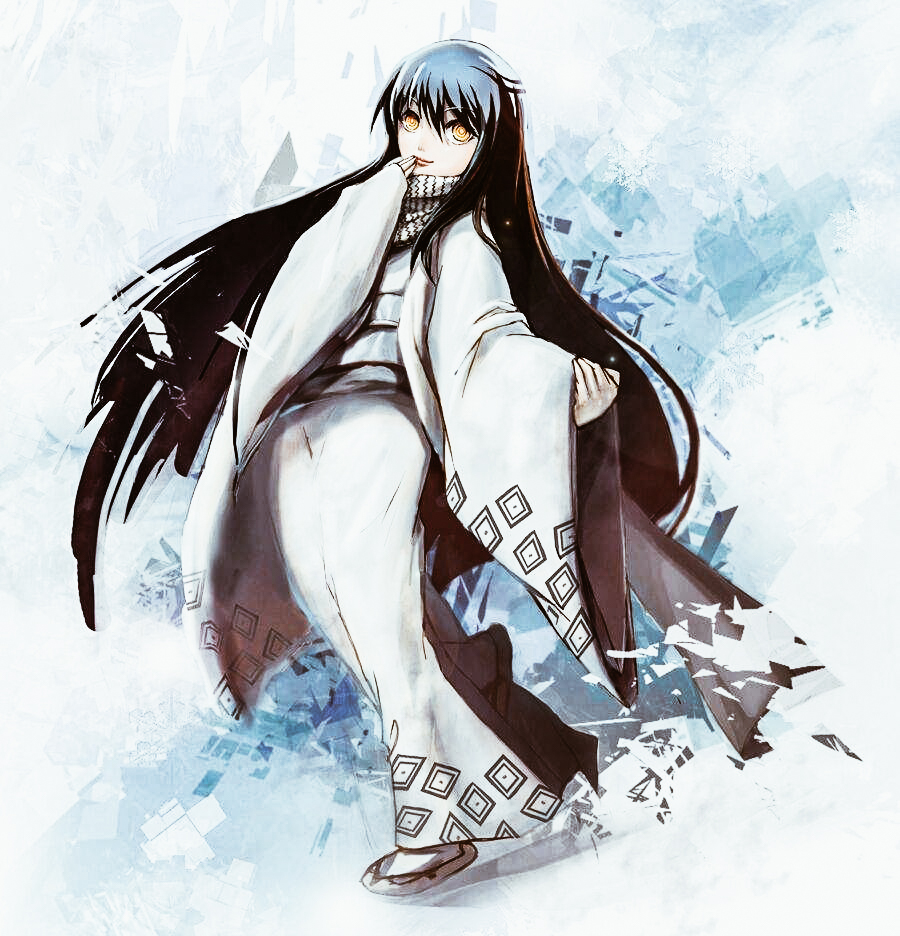
photo credits: aminoapps.com
La Yuki-Onna nell’età contemporanea
Come la sposa di Minokichi, la leggenda della Yuki-onna, crudele e romantica al tempo stesso, sembra conservare intatto il proprio fascino nei secoli.
Infatti, in epoca contemporanea ha ispirato numerosi film. Ricordiamo infatti Kwaidan (怪談) del 1965, diretto da Masaki Kobayashi, vincitore del premio speciale della giuria al Festival di Cannes. Kwaidan fu anche in lizza agli Academy Award con una nomination per il Miglior film in lingua straniera.
Al successo di questo film ha fatto seguito, nel 1968, Kaidan yukijoro di Tokuzô Tanaka, fino ad arrivare nel 2016 con Yuki-Onna, diretto e interpretato da Kiki Sugino.
La bella e letale donna delle nevi, nelle sue innumerevoli varianti, compare poi come protagonista o personaggio di spicco in una vastissima gamma di videogiochi, anime e manga. Ricordiamo Nurarihyon no Mago o Ranma ½, solo per citarne alcuni. Tuttavia, il suo intramontabile fascino continuerà ad ammaliarci ancora a lungo, col suo eterno, candido inverno.
Japan Folklore: Setsubun, come scacciare i demoni dell’inverno per accogliere la primavera

photo credits: pinterest.it
La cultura tradizionale giapponese è sempre stata caratterizzata da una costante ed amorevole osservazione del mondo naturale, delle sue manifestazioni e dei suoi cicli stagionali. Non deve quindi meravigliare l’attenzione riservata alla primavera, lo speciale momento in cui la natura risveglia in tutte le sue creature la necessità del rinnovamento.
Questa stagione è celebrata in Giappone con l’haru matsuri (春祭, festival di primavera), un insieme di eventi il cui inizio è segnato dalla ricorrenza di Setsubun (節分). Nel tradizionale calendario lunisolare giapponese, infatti, ogni cambio di stagione è introdotto da un giorno chiamato, appunto, setsubun (letteralmente “divisione delle stagioni”). Il setsubun di primavera, che cade il 3 febbraio, rappresenta l’ultimo giorno dell’inverno e il giorno che precede l’inizio della nuova stagione. Segna quindi il passaggio dal “Taikan” (大寒, grande freddo) al “Risshun” (立春, primo giorno di primavera) ed è perciò il momento più propizio per una speciale “pulizia” dai fardelli invernali, che allontanerà gli spiriti maligni e favorirà l’ingresso della nuova energia vivificante. E’ questo il senso della tradizionale “cacciata dei demoni” che ha luogo in questo giorno attraverso diversi riti ed usanze.
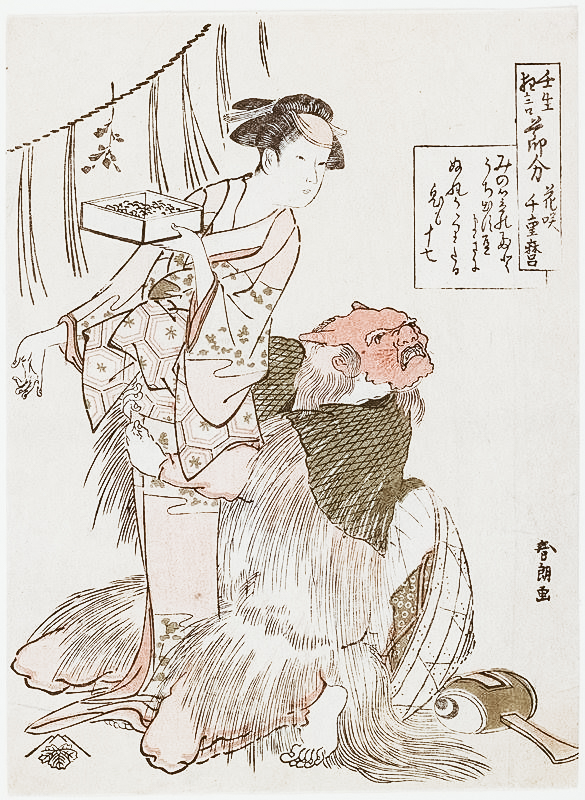
photo credits: pinimg.com
Antichi rituali e divertimento per famiglie
Il rituale più famoso è senza dubbio il mamemaki (豆撒き), ovvero il lancio dei fagioli di soia. In ambito domestico esso è affidato al Toshi Otoko (年男, uomo dell’anno), cioè l’uomo della famiglia del segno zodiacale dell’anno lunare entrante o in sua assenza il più anziano di casa; costui ha il compito di scacciare gli spiriti nocivi e le negatività dalla casa e dal nuovo periodo dell’anno che sta per iniziare lanciando in giro irimame (炒り豆, fagioli di soia tostati) al grido di “Oni wa soto! fuku wa uchi! (鬼は外! 福は内, “Fuori i demoni! Dentro la fortuna!”). In alternativa si possono scagliare gli irimame contro un altro membro della famiglia che interpreta la parte del demone indossando una maschera da oni (orchi del folcklore giapponese). Successivamente ogni componente della famiglia deve raccogliere e mangiare un numero di fagioli corrispondente alla propria età più uno per assicurarsi un anno di successi e buona salute (nella tradizione popolare, infatti, i demoni sono ritenuti portatori di catastrofi naturali e malattie). Scacciato l’oni, è però necessario tenere gli spiriti maligni lontani dalla casa. Per questo è possibile vedere in questo periodo dell’anno dei particolarissimi amuleti, gli Hiiragi Iwashi (柊鰯), esposti all’ingresso delle abitazioni. Si tratta di rami di agrifoglio che presentano la testa di una sardina essiccata infilzata sull’estremità, talvolta completati da pezzi di aglio o cipolla, che hanno appunto lo scopo di tenere lontani i demoni, timorosi delle spine e dell’ odore pungente emanato da questi talismani.
Si tratta in entrambi i casi di tradizioni che affondano le proprie radici nell’antichità. Al giorno d’oggi è possibile acquistare “set da Setsubun” - composti da maschere da oni e fagioli tostati - in qualsiasi conbini, ma in realtà l’usanza del mamemaki avrebbe avuto origine nel periodo Muromachi (1392-1573) e sembra essere ispirata ad un’antichissima leggenda, la cui trama viene tuttora rappresentata in forma di pantomima nel tempio di Mibu-dera a Kyoto. Qui il kyogen (antica forma teatrale giapponese) intitolato “Setsubun” viene replicato più volte nel corso della giornata e si dice che basti assistere ad esso per essere purificati da ogni spirito negativo o malvagio. La sua trama ricalca il racconto folkloristico che narra di un orco il quale, sotto sembianze umane, si reca un giorno a far visita ad una vedova. Grazie al suo martello magico, l’orco confeziona un bellissimo kimono, che attira l’attenzione della vedova. Desiderosa di impossessarsi non solo del kimono ma anche del martello magico, essa decide di farlo ubriacare per poterglieli rubare entrambi. L’orco, però, accortosi del furto, rivela la propria natura demoniaca ed attacca la donna, che per difendersi gli scaglia contro la prima cosa che trova a portata di mano: un pugno di fagioli di soia. L’oni, ferito ma di nuovo in possesso dei suoi beni, fugge lasciando la vedova sana e salva e forse un po’ più saggia.

photo credits: toyokeizai.net
Saper guardare nella giusta direzione
Un’usanza di origini più recenti, nata ad Osaka ma successivamente diffusasi nel resto del paese, è invece quella legata all’ehōmaki (恵方巻, rotolo della direzione fortunata). In questo caso, per assicurarsi che la buona sorte sia al nostro fianco nell’anno che sta per iniziare, è necessario mangiare uno speciale rotolo di sushi in un’unica soluzione, senza interruzioni ed in silenzio, rivolti nella direzione fortunata dell’anno. L’impresa è meno semplice di quel che può sembrare, considerando che l’ehōmaki è molto più spesso di un comune sushi roll (dovendo contenere sette ingredienti per propiziarsi i sette dei della fortuna) ed è lungo 20 centimetri. Non vale mangiarlo tagliato in pezzi, perché così facendo si taglierebbe anche la fortuna. Per compiere correttamente il rituale è necessario quindi armarsi di concentrazione, determinazione e di una bussola precisa. Per chi fosse interessato a sperimentare questa usanza, gli ingredienti più comuni da procurarsi per la farcitura sono cetriolo, surimi, salmone, tonno, anago (anguilla di mare), tamagoyaki (omelette giapponese), strisce di kanpyo essiccate e condite (zucca giapponese) e funghi shiitake, oltre naturalmente al riso e all’alga nori, mentre la direzione fortunata per il 2019 è Est-NordEst.
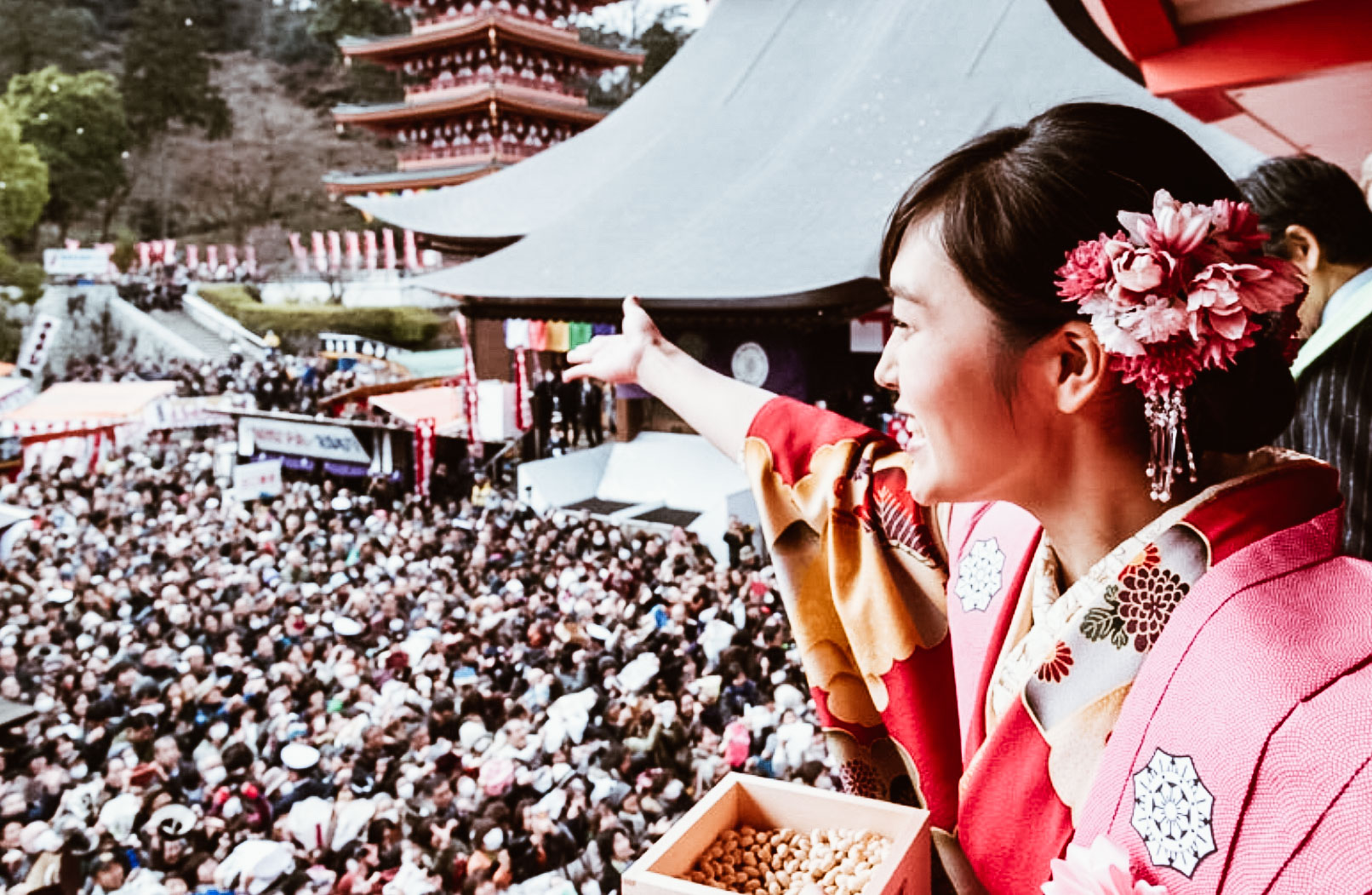
photo credits: shinsenhino.com
Templi in festa
Il Setsubun può essere celebrato in un ambiente domestico o comunque in una dimensione privata, con parenti ed amici, ma è anche e soprattutto una ricorrenza da vivere in comunità. Ad esempio nelle scuole vengono spesso organizzati momenti di ricreazione per i bambini, che indossano maschere da oni o si divertono a dare la caccia ad adulti travestiti da demoni, rincorrendoli e scagliando loro fagioli. Ma è in particolare nei templi che è possibile vivere la dimensione collettiva della festa, partecipando agli eventi appositamente realizzati per questa giornata. Primo fra tutti naturalmente il mamemaki, effettuato dai monaci che dall’alto di appositi palchi lanciano fagioli di soia sulla folla radunata per l’evento. In alcuni templi vengono organizzati più turni per questo rituale, riservandone alcuni speciali ai bambini, che oltre ai fagioli ricevono dolci o piccoli doni. Oltre ai monaci sono spesso presenti personaggi celebri, come campioni sportivi, protagonisti del mondo dello spettacolo, attori del teatro kabuki, geisha e maiko, celebrità televisive, che aggiungono una nota di attrattiva glamour ai festeggiamenti tradizionali. Tra questi ultimi vanno ricordati gli spettacoli teatrali, le diverse cerimonie di purificazione o anche le suggestive esibizioni di tiro con l’arco, in cui gli arcieri scagliano le proprie frecce contro bersagli che hanno fattezze di demoni.
Setsubun è insomma la giornata ideale per coloro che desiderano vivere in compagnia un inizio d’anno che aiuti a rinnovare le proprie energie e per le famiglie che hanno l’opportunità di trascorrere insieme un momento di allegria, cosa che ad ogni latitudine resta sempre il miglior talismano contro ogni male.







